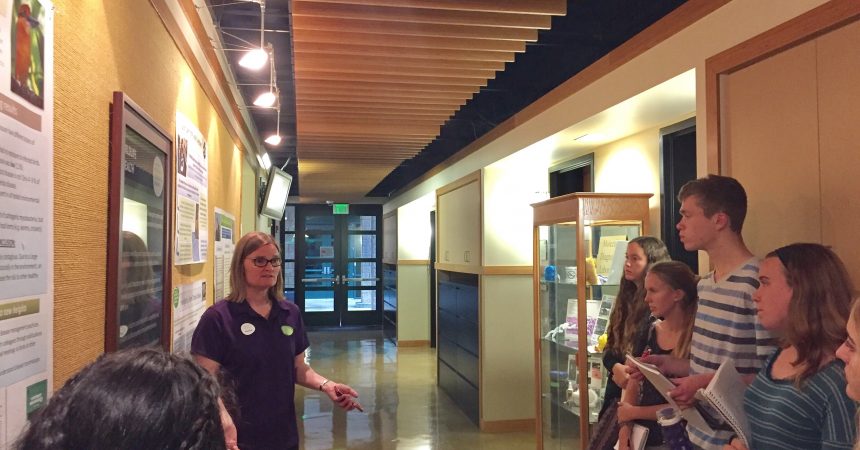Zoo InternQuest is a seven-week career exploration program for San Diego County high school juniors and seniors. Students have the unique opportunity to meet professionals working for the San Diego Zoo, Safari Park, and Institute for Conservation Research, learn about their jobs, and then blog about their experience online. Follow their adventures here on the Zoo’s website!
 This week we met with Maggie Reinbold, the Director of Conservation Education for the San Diego Zoo’s Institute for Conservation Research. Ms. Reinbold leads the Conservation Education team in teaching kids and teachers about the importance of conservation. She focuses on the human side of conservation, because after all, humans are the main culprits causing habitat and species endangerment.
This week we met with Maggie Reinbold, the Director of Conservation Education for the San Diego Zoo’s Institute for Conservation Research. Ms. Reinbold leads the Conservation Education team in teaching kids and teachers about the importance of conservation. She focuses on the human side of conservation, because after all, humans are the main culprits causing habitat and species endangerment.
So, wait a minute, humans can really affect the wellbeing of wild species? Absolutely! In fact, electric shocks from power lines, litter, and hunting are the main factors that caused the California condor to become critically endangered in 1994. Did you know that California condors are the largest birds in North America? They have an average wingspan of a whopping 9.5 feet! In 1982, there were only 25 birds left, but thanks to hard work and dedication, there are now more than 430 birds alive; over half are flying free in the wild. However, one problem the birds still encounter upon release is microtrash. Unfortunately, condors confuse small pieces of trash as bone fragments, which are then usually fed to their young. As you can imagine, this is a big issue and results in many condor fatalities. With the help of several other conservation organizations, the Zoo’s team was able to condition the birds to be able to differentiate between trash and food, and trash ingestion is on the decline.
Despite the condor’s success, litter is still a major danger for species all over the world. Animals run into trouble from either consuming trash or becoming entangled or suffocated by it. So, what can we do to help? According to Ms. Reinbold, there are lots of simple ways to reduce our waste and encourage others to do so as well. Saying no to plastic straws, using reusable shopping bags, and sharing about you efforts on social media to get the word out are all awesome ways to step up your conservation game.
Lesson: Complete the 30-Day Litter Mission!
Objectives: Children will gain awareness of how much trash is left behind by people and learn the importance of properly disposing of their own trash. Additionally, they will realize the big impact small, everyday actions can have over an extended period of time. It’s a great way to get kids thinking more about their environment and encourage conscientiousness!
Materials:
-Trash collecting bags
-Gloves or something to use to pick up the trash
-Hand sanitizer
-Scavenger hunt checklist
Directions:
-Write a list of 30 pieces of litter you wish to pick up this month. For example, you could include things like soda cans, water bottles, candy wrappers, straws, and anything else you think of!
-Next, decide the places where you are going to litter hunt. You could go to a nearby hiking trail or check out the beach, or even just walk around your neighborhood block
-As you hunt, check off the types of trash you are able to find and track your progress for the month
-Once you’ve picked up a bunch of litter, spend some time enjoying the area that you just cleaned up!
-Lastly, don’t forget to wash your hands after you’ve finished!
Jasmine, Kid’s Corner Team
Week One, Winter Session 2017


